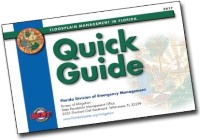Community Resources
 Quick Guide for Floodplain Management
Quick Guide for Floodplain Management
Illustrated guide for floodplain management in Florida, available for desktop printing and an Adobe® Slideshow. The Quick Guide is intended to provide an overview for non-technical local staff and is useful to refresh what local floodplain administrators already know about managing flood hazard areas.
Floodplain Management Performance Measures
Technical Bulletins
Manufactured Homes
Substantial Improvement/Substantial Damage
Guidance for Some Activities
Local Coordination Resources
Letters of Map Change
Florida Post-Disaster Toolkit for Floodplain Administrators
Download the Post Disaster Toolkit
- ACTION 1. Plan ahead to communicate with elected officials and citizens. Identifies elements for a communications plan. Encourages working with other community officials, public information office and Emergency Manager to fill in the details.
- ACTION 2. Assess post-disaster needs and request assistance. Provides an overview of the State Mutual Aid Agreement and Emergency Management Assistance Compact so community officials will know how to request assistance from within and outside the State.
- ACTION 3. Document high water marks. Describes how to collect and document high water marks and post data in real time on FDEM’s GIS website.
- ACTION 4. Make substantial damage determinations and use FEMA’s Substantial Damage Estimator. Explains conducting SI/SD determinations and using FEMA’s Substantial Damage Estimator (SDE). The SDE is a powerful tool that is effective to collect data on damaged buildings to make substantial damage determinations.
- ACTION 5. Understand NFIP claims and Increased Cost of Compliance. Describes how property owners who have NFIP flood insurance policies on buildings substantially damaged by flooding may qualify for Increased Cost of Compliance claim payments to help bring buildings into compliance. Links to FEMA’s brochures and FAQs.
- ACTION 6. Identify post-disaster and mitigation funding assistance. Provides an overview of post-disaster and mitigation funding programs and other sources of funding. Refers to the Local Mitigation Strategy plans for details on local project priorities.
Substantial Damage
Substantial Improvement/Substantial Damage Desk Reference(FEMA P-758)
Please visit the Substantial Damage Resources page for more information about Substantial Damage.
Since the 2010 edition, the flood provisions of the Florida Building Code (FBC) meet or exceed the minimum NFIP requirements for buildings and structures. Florida communities rely on the FBC and local floodplain management ordinances to fulfill the requirements for participation in the NFIP.
Every 3 years, the Florida Building Commission develops the next edition of the FBC. In accordance with Florida Statute, communities may amend the FBC to be more restrictive. Local amendments for flood higher standards do not sunset every three years.
Guidance and instructions for amending local floodplain management ordinances and guidance for higher standards that require local amendments to the Florida Building Code are available on the Guidance, Ordinance Amendments, FBC Amendments and Sample Forms page.
Guidance and instructions for amending local floodplain management ordinances and guidance for higher standards that require local amendments to the Florida Building Code are available on the Guidance, Ordinance Amendments, FBC Amendments and Sample Forms page.
8th Edition (2023) Florida Building Code
7th Edition (2020) Florida Building Code
6th Edition (2017) Florida Building Code
-
- Flood provisions of the 6th Edition Florida Building Code
- 6th Ed Changes from the 5th Ed FBC
- Highlights of ASCE 24-14 Flood Resistant Design and Construction (FEMA)
- Flood Resistant Construction and the 6th Edition FBC (Fact Sheet by Building A Safer Florida, BASF)
- Revised CCCL Requirements in the 6th Edition FBC (Fact Sheet by Building A Safer Florida, BASF)
5th Edition (2014) Florida Building Code
The Office of Floodplain Management (OFM) must review draft amendments at least 30 days before presenting the amendments to planning boards or elected officials. Instructions explain how to send to the OFM.
Guidance
-
-
- Approximate Zone A Guidance (12/2024)
- Attached Garages and Enclosure Floors/Slabs and Flood Openings (12/2024)
- Accessory Structures: Non-elevated, wet floodproofed (12/2024)
- Coastal High Hazard Area: Floodplain Management vs Comprehensive Planning (12/2024)
- Comparison of CCCL Sec. 3109 and Flood Requirements in FBC (12/2024)
- Date of Entry or First Ordinance (definitions) (12/2024)
- Flood Study and Map Revision Guidance
- Market Value: Adjustment Factors Applied to Tax Assessment Values (12/2024)
- Swimming Pools, Spas, and Similar Water Features in SFHAs (12/2024)
-
Floodplain Management Ordinance Amendments
-
-
- Agricultural structures: variance for wet floodproofing (12/2024)
- Amend Market Value: Actual Cash Value (12/2024)
- Manufactured homes
- Contact OFM for assistance to prepare other ordinance amendments, including:
- Adopt local flood hazard area maps in addition to FIS and FIRMs
- Critical facilities
- Compensatory storage
- Certified Floodplain Manager: Floodplain Administrator
- Limit the use of fill for purposes other than to elevate buildings
- Zone X (elevation relative to highest adjacent grade or crown of road)
- Subdivision (building footprints outside of SFHA)
- Hazardous materials limitations
- Setbacks: small streams without SFHA; streams without BFE; streams with BFE, without Floodway
-
Florida Building Code Amendments for Higher Standards
Sec. 553.75(4), Florida Statutes, allows communities to adopt local amendments to the FBC. Sec. 553.73(5), F.S., specifically permits higher standards for floodplain management that, if properly adopted, do not sunset every three years.
- Guidance for “Plain Language” Local Amendments to the FBC (12/2024) includes guidance for: fdem-ofm-guidance_fbc-amendments-for-flood_12-2024.pdf
-
- Additional Height: Freeboard
- Treat CAZ exactly like Zone V
- Cumulative Substantial Improvement
- Lower SI & SD Percentages
- Enclosures: No partitions and/or limited access
- Enclosures: Limit size
- Enclosures: Not permitted
- Dwellings: Foundations in Zone A/AE designed by RDP
- Dwellings: Open foundations in Zone A/AE (limit the use of fill)
- Repetitive Flood Damage as part of Substantial Damage
Sample Forms

